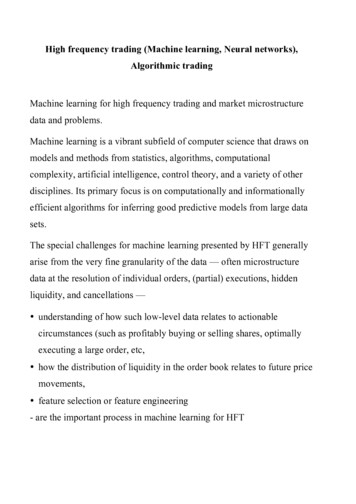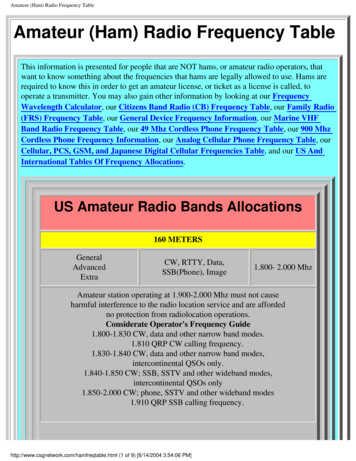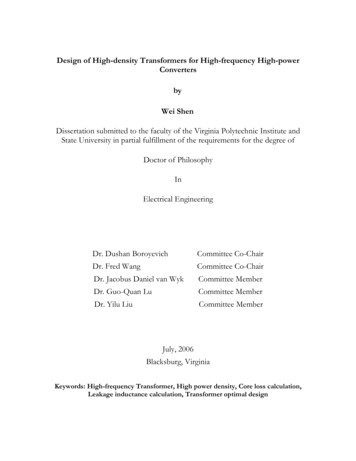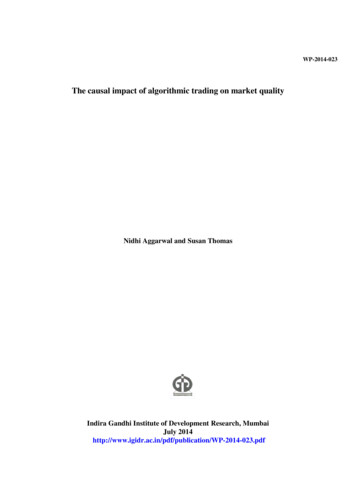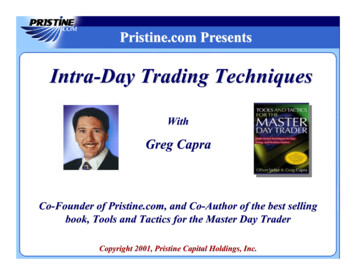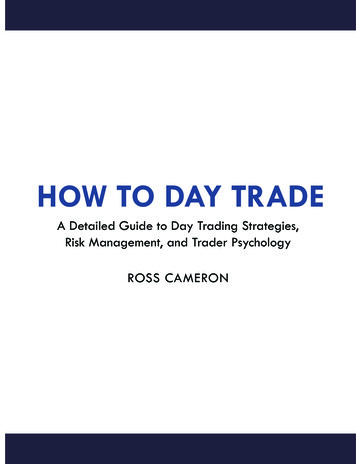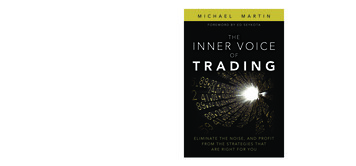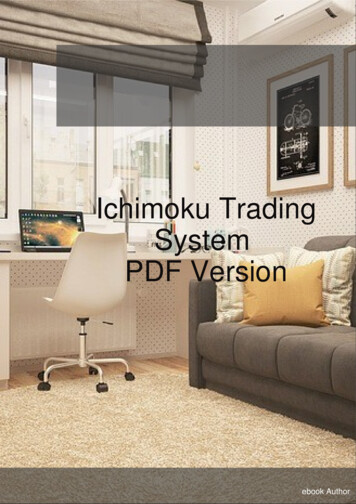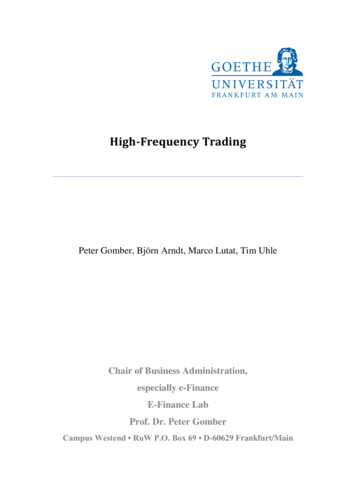
Transcription
High-Frequency TradingPeter Gomber, Björn Arndt, Marco Lutat, Tim UhleChair of Business Administration,especially e-FinanceE-Finance LabProf. Dr. Peter GomberCampus Westend RuW P.O. Box 69 D-60629 Frankfurt/Main
Commissioned by
Executive SummaryHigh-frequency trading (HFT) has recently drawn massive public attention fuelled by theU.S. May 6, 2010 flash crash and the tremendous increases in trading volumes of HFTstrategies. Indisputably, HFT is an important factor in markets that are driven bysophisticated technology on all layers of the trading value chain. However, discussions onthis topic often lack sufficient and precise information. A remarkable gap between theresults of academic research on HFT and its perceived impact on markets in the public,media and regulatory discussions can be observed.The research at hand aims to provide up-to-date background information on HFT. Thisincludes definitions, drivers, strategies, academic research and current regulatorydiscussions. It analyzes HFT and thus contributes to the ongoing discussions by evaluatingcertain proposed regulatory measures, trying to offer new perspectives and deliver solutionproposals. Our main results are:HFT is a technical means to implement established trading strategies. HFT is not atrading strategy as such but applies the latest technological advances in market access,market data access and order routing to maximize the returns of established tradingstrategies. Therefore, the assessment and the regulatory discussion about HFT should focuson underlying strategies rather than on HFT as such.HFT is a natural evolution of the securities markets instead of a completely newphenomenon. There is a clear evolutionary process in the adoption of new technologiestriggered by competition, innovation and regulation. Like all other technologies, algorithmictrading (AT) and HFT enable sophisticated market participants to achieve legitimaterewards on their investments – especially in technology – and compensation for theirmarket, counterparty and operational risk exposures.A lot of problems related to HFT are rooted in the U.S. market structure. The flashcrash and the discussions on flash orders relate to the U.S. equity markets and the NMS. InEurope, where a more flexible best execution regime is implemented and a share-by-sharevolatility safeguard regime has been in place for two decades, no market quality problemsrelated to HFT have been documented so far. Therefore, a European approach to the subjectmatter is required and Europe should be cautious in addressing and fixing a problem thatexists in a different market structure thereby creating risks for market efficiency and marketquality.1
The majority of HFT based strategies contributes to market liquidity (market makingstrategies) or to price discovery and market efficiency (arbitrage strategies). Preventingthese strategies by inadequate regulation or by impairing underlying business modelsthrough excessive burdens may trigger counterproductive and unforeseen effects to marketquality. However, any abusive strategies against market integrity must be effectivelycombated by supervisory authorities.Academic literature mostly shows positive effects of HFT based strategies on marketquality. The majority of papers, focusing on HFT, do not find evidence for negative effectsof HFT on market quality. On the contrary, the majority argues that HFT generallycontributes to market quality and price formation and finds positive effects on liquidity andshort term volatility. Only one paper critically points out that under certain circumstancesHFT might increase an adverse selection problem and in case of the flash crash one studydocuments that HFT exacerbated volatility. As empirical research is restricted by a lack ofaccessible and reliable data, further research is highly desirable.In contrast to internalization or dark pool trading, HFT market making strategies facerelevant adverse selection costs as they are providing liquidity on lit markets withoutknowing their counterparties. In internalization systems or dark venues in the OTC space,banks and brokers know the identity of their counterparty and are able to ―cream skim‖uninformed order flow. In contrast, HFTs on lit markets are not informed on the toxicity oftheir counterparts and face the traditional adverse selection problems of market makers.Any assessment of HFT based strategies has to take a functional rather than aninstitutional approach. HFT is applied by different groups of market players frominvestment banks to specialized boutiques. Any regulatory approach focusing on specializedplayers alone risks (i) to undermine a level playing field and (ii) exclude a relevant part ofHFT strategies.The high penetration of HFT based strategies underscores the dependency of playersin today’s financial markets on reliable and thoroughly supervised technology.Therefore, (i) entities running HFT strategies need to be able to log and record algorithms‘input and output parameters for supervisory investigations and back-testing, (ii) marketshave to be able to handle peak volumes and have to be capable of protecting themselvesagainst technical failures in members‘ algorithms, (iii) regulators need a full picture ofpotential systemic risks triggered by HFT and require people with specific skills as well asregulatory tools to assess trading algorithms and their functionality.2
Any regulatory interventions in Europe should try to preserve the benefits of HFTwhile mitigating the risks as far as possible by assuring that (i) a diversity of tradingstrategies prevails and that artificial systemic risks are prevented, (ii) economic rationalerather than obligations drive the willingness of traders to act as liquidity providers, (iii) colocation and proximity services are implemented on a level playing field, (iv) instead ofmarket making obligations or minimum quote lifetimes, the focus is on the alignment ofvolatility safeguards among European trading venues that reflect the HFT reality and ensurethat all investors are able to adequately react in times of market stress.The market relevance of HFT requires supervision but also transparency and opencommunication to assure confidence and trust in securities markets. Given the publicsensitivity to innovations in the financial sector after the crisis, it is the responsibility ofentities applying HFT to proactively communicate on their internal safeguards and riskmanagement mechanisms. HFT entities act in their own interest by contributing to anenvironment where objectivity rather than perception leads the debate: They have to drawattention to the fact that they are an evolution of securities markets, supply liquidity andcontribute to price discovery for the benefit of markets.3
Contents1Introduction . 62Evolution of Electronic Trading. 832.1Historical Background and Electronification of Securities Trading . 82.2Drivers for Widespread Usage of Algorithmic/High-Frequency Trading . 9High-Frequency Trading Definitions and Related Concepts . 133.1Why Algorithmic/High-Frequency Trading Need Clear Definitions. 133.2Delineating Algorithmic and High-Frequency Trading . 133.2.1Algorithmic Trading . 133.2.2High-frequency trading. 143.34Related Concepts . 163.3.1Market Making . 163.3.2Quantitative Portfolio Management (QPM) . 183.3.3Smart Order Routing (SOR) . 19Algorithmic and High-Frequency Trading Strategies . 214.1Algorithmic Trading Strategies . 214.1.1The Scope of Algorithmic Trading Strategies . 214.1.2First Generation Execution Algorithms . 214.1.3Second Generation Execution Algorithms . 234.1.4Third Generation Execution Algorithms . 234.1.5Newsreader Algorithms . 234.2High-Frequency Trading Strategies . 244.2.1The Scope of HFT Strategies. 244.2.2Electronic Liquidity Provision. 254.2.3(Statistical) Arbitrage . 274
564.2.4Liquidity Detection . 284.2.5Other High-Frequency Trading Strategies. 294.2.6Summary of Algorithmic and High-Frequency Trading Strategies. 30Systematic Analysis of Academic Literature . 325.1Market Quality . 325.2Fairness and Co-location . 345.3Market Penetration and Profitability . 365.4Summary of Academic Literature Review . 37Status of High-Frequency Trading Regulation and Regulatory Discussion . 396.1Differences between the U.S. and the European Market System . 396.2Regulatory Initiatives Concerning High-Frequency Trading in the U.S. 406.2.1Naked/Unfiltered Sponsored Access . 416.2.2Flash Orders. 426.2.3Co-location/Proximity Hosting Services . 436.2.4Large Trader Reporting System. 436.2.5The Flash Crash and Resulting Regulation . 446.37Regulatory Initiatives Concerning High-Frequency Trading in Europe . 466.3.1CESR Technical Advice to the European Commission. 476.3.2Report on Regulation of Trading in Financial Instruments . 486.3.3Review of the Markets in Financial Instruments Directive (MiFID) . 496.3.4Summary of Regulatory Status and Discussion. 50Conclusions . 58References . 63Appendix I – High-Frequency Trading Market Sizing . 72Appendix II – Academic and Regulatory Definitions of Algorithmic Trading . 74Appendix III - Academic and Regulatory Definitions of High-Frequency Trading . 76Appendix IV - Academic Literature Overview on High Frequency/Algorithmic Trading . 785
1IntroductionFor hundreds of years, exchanges were organized as physical venues where marketparticipants met to exchange their trading interests. Traditionally, floor-based trading wassupported by designated market intermediaries who arranged trades between differentmarket participants. In the last decades, securities trading experienced significant changesand more and more stages in the trading process were automated by incorporating electronicsystems. Nowadays, the securities trading landscape is characterized by fragmentationamong trading venues and competition for order flow, different market access models and asignificant market share of automated trading technologies like algorithmic trading (AT)and high-frequency trading (HFT).Algorithmic trading1 has altered the traditional relationship between investors and theirmarket access intermediaries in agent trading. Computer algorithms which generate ordersfor trading individual instruments without any human intervention have been appliedinternally by sell side firms for years2. However, with the help of new market accessmodels, the buy side has gained more control over the actual trading decision and orderallocation processes and is enabled to develop and implement their own trading algorithms3or uses standard software solutions from independent software vendors (ISV). Nevertheless,the sell side still offers the majority of AT tools to their clients. Applying computeralgorithms that generate orders automatically has reduced the overall trading costs forinvestors, as no expensive human traders are involved any longer. Consequently, AT hasgained significant market shares in international financial markets in recent years.The term high-frequency trading has emerged in the last five years and has gained somesignificant attention due to the flash crash in the U.S. on May 6, 2010. While AT is mostlyassociated with the execution of client orders, HFT relates to the implementation ofproprietary trading strategies by technologically advanced market participants. HFT is often1The proliferation of AT is also documented in various descriptive surveys, e.g. Financial Insights(2005) and Financial Insights (2006) or EDHEC-Risk Advisory (2005). Directories are publiclyavailable that list providers of AT and their algorithms (A-Team Group 2009).2Although program trading notionally sounds alike, this is not related to applying computeralgorithms to trading, but rather to buying or selling bundles of instruments.3However, in order to apply their own algorithmic trading solutions, buy side institutions needsufficient trading expertise to integrate and parameterize their own algorithms into their tradingdesks. As Engdahl and Devarajan (2006) point out: ―With the exception of advanced quantitativetrading houses, buy side trading desks are generally not equipped to build and deploy their ownalgorithms.‖ The development of AT software is associated with considerable costs and most buyside institutions lack the technical expertise and/or the funds necessary for deploying their own ATsolutions. Those investment firms buy customizable AT solutions either from brokers orindependent software vendors (ISV).6
seen as a subgroup of AT, however, both AT and HFT enable market participants todramatically speed up the reception of market data, internal calculation procedures, ordersubmission and reception of execution confirmations. Currently, regulators around the globeare discussing whether there is a need for regulatory intervention in HFT activities.Figures concerning the market shares of HFT trading have been addressed in the responsesto CESR‘s (CESR 2010a) Call for Evidence on Micro-structural Issues of the EuropeanEquity Markets (see Table 5 in the Appendix I). According to the trading platforms‘responses, the HFT market shares in European equities trading range from 13% (NasdaqOMX) to 40% (Chi-X). Based on studies originating from the securities industry andacademic literature, market shares from 40% (Tradeworx 2010a) to 70% (Swinburne 2010)are reported for the U.S. and 19% (Jarrnecic and Snape 2010) to 40% (Swinburne 2010) canbe found for Europe (see Table 6 in Appendix I). The Australian regulator ASIC reports thatHFT activity in the Australian market as significantly lower, where a market share at around10% can be observed (ASIC 2010a).This paper is to provide background information on the proliferation of AT and HFT (due tothe current discussions the main focus is set on HFT). It aims at supporting the public,policy makers and regulators in discussions around AT and HFT and in assessing potentialregulatory steps on an informed basis. The remainder of this paper is structured as follows:Section 2 will provide some historical background and outlines drivers for AT and HFT asthese technologies are linked to a multitude of recent developments and innovations insecurities trading. In order to offer a clear foundation for further discussions, section 3defines HFT and distinguishes it from other automated trading strategies, particularly fromAT. In this context, common and distinct characteristics of AT and HFT strategies will bediscussed. Trading strategies, that are based on HFT and AT as a technology, will bepresented in the subsequent section 4. A review of academic literature on AT and HFT willbe delivered in section 5. Regulatory discussions and initiatives on HFT in the U.S. and inEurope are presented in section 6 and eventually, the last section concludes with a series ofpolicy implications for a potential regulatory handling of HFT.7
22.1Evolution of Electronic TradingHistorical Background and Electronification of Securities TradingThe electronification of securities trading commenced 40 years ago, when the NationalAssociation of Securities Dealers (NASD) started its computer-assisted market makingsystem for automated quotation (AQ) in the U.S., forming what is nowadays known asNASDAQ (Black 1971a; Black 1971b). In Europe, the first computer-assisted equitiesexchanges launched their trading services in the 1980s, but not until the 1990s securitiestrading was organized in fully automated exchanges.The majority of market models of those fully automated equities exchanges areimplemented as electronic central limit order books (CLOB), which store marketparticipants‘ trading interests visible to and executable for all other connected traders.According to Pagano and Roell (1996) and Jain (2005), the transparency induced by theintroduction of CLOBs reduces information asymmetry, enhances liquidity and supportsefficient price determination. While prices were determined manually in floor trading,orders are matched automatically according to price-time priority in electronic tradingsystems.4 By applying uniform rules to all market participants, operational fairness and fairaccess to the respective trading venue shall be ensured (Harris 2003).Thereby, the electronification of securities markets and the electronic connectivity of marketparticipants went hand in hand, leading to decentralized market access. Physical tradingfloors were not required any longer and have mostly been replaced by electronic tradingsystems. Investors can submit their orders electronically to a market‘s backend from remotelocations.On the investors‘ side, human trading processes have been substituted by electronic systems,too. While systems generating automated quotes and stop-loss orders were the firsttechnological artifacts that conquered the trading process, in recent years informationtechnology (IT) has successively established and can nowadays be found on every stage oftrading and post-trading processes. State-of-the-art technology has developed as a crucialcompetitive factor for market operators in recent decades and market participantsthemselves continued to further automate and optimize their trading processes along theentire value chain.4Although slight modifications exist, price-time priority has established as a de-facto standard insecurities trading globally.8
2.2Drivers for Widespread Usage of Algorithmic/High-Frequency TradingThe emergence of AT and HFT in the past went hand in hand with other market structuraldevelopments in European securities trading. In the following, multiple drivers for the riseof AT and HFT are identified, i.e. new market access models and fee structures, asignificant reduction of latency and an increase in competition for and fragmentation oforder flow5.In most markets, only registered members are granted direct access.6 Hence, those membersare the only ones allowed to conduct trading directly, leading to their primary role as marketaccess intermediaries for other investors. Market members performing that function arereferred to as brokers7. In the past, those access intermediaries transformed their clients‘general investment decisions into orders that were allocated to appropriate market venues.As the cost awareness of the buy side has increased over the years, brokers have begun toprovide different market access models, i.e. direct market access (DMA) and sponsoredaccess (SA). When an investor makes use of DMA, his orders are no longer touched by thebroker, but rather forwarded directly to the markets through the broker‘s infrastructure. Onekey characteristic of DMA presents the fact that the respective broker can conduct pre-traderisk checks.Sponsored access (SA) represents a slightly different possibility for the buy side to access amarketplace. Here, an investment firm (that is not a member of the respective market) isenabled to route its orders to the market directly using a registered broker‘s member IDwithout using the latter‘s infrastructure (in contrast to DMA). Resulting from this setup, thesponsor can conduct pre-trade risk checks only if the option to conduct those checks isprovided by the trading venue (filtered SA). In case of unfiltered (also referred to as naked)SA, the sponsor only receives a drop copy of each order to control his own risk exposure. Areduction in latency represents the main advantage of SA over DMA from a non-memberfirm‘s perspective and therefore is highly attractive for AT or HFT based trading strategies.Another driver for the success of AT and HFT is the new trading fee structures found inEurope. Market operators try to attract order flow that is generated automatically (i) byapplying special discounts for algorithmic orders within their fee schedules. MTFs5Obviously, this list of drivers is not exhaustive. Other drivers that could be listed additionallyinclude, e.g., the growing number of proprietary trading firms founded by former investment bankstaffers and other mathematically/technically oriented traders.6Access is restricted to registered market members mainly due to post-trading issues, i.e. clearing andsettlement. A pre-requisite for trading directly in a market is an approved relationship with therespective clearing house(s).7As brokers basically offer their services to other market participants they are also referred to as thesell side. Respective clients purchasing those services are referred to as the buy side (Harris 2003).9
implemented (ii) fee schedules with very aggressive levels to compete with incumbentexchanges. Furthermore, some MTFs like e.g. Chi-X, BATS or Turquoise started offeringpricing schemes that are a novelty to European exchange fee schedules: (iii) asymmetricpricing (Jeffs 2009; Mehta 2008). With asymmetric pricing, market participants removingliquidity from the market (taker) are charged a higher fee while traders that submit liquidityto the market (maker) are charged a lower fee or are even provided with a rebate. Such anasymmetric fee structure is supposed to incentivize liquidity provision. Faced with theMTFs‘ aggressive pricing strategies, many European exchanges were urged to lower theirfee levels as well, while others even adopted the asymmetric pricing regime. As will befurther explained in section 4, market participants have specialized in making profits fromthose fee structures by applying trading algorithms.Although latency has always been of importance in securities trading, its role is moreintensely stressed by market participants with AT/HFT on the rise. In traditional tradinginvolving human interaction on trading floors, a trader could also profit from trading fasterthan others. Traders often benefited from their physical abilities, e.g. when they could runfaster across the trading floor or shout louder than their counterparts and thus drew a marketmaker‘s or specialist‘s attention to their trading intentions. With algorithms negotiating onprices nowadays, those physical advantages are no longer needed. Nevertheless, in marketstrading at high speed, the capability to receive data and submit orders at lowest latency isessential. When the market situation at the arrival of an order differs significantly from themarket situation, which led to that particular trading decision, there is a risk that the order isno longer appropriate in terms of size and/or limit (Harris 2003; Brown and Holden 2005;Liu 2009). Hence, an order bears the risk of being executed at an improper price or notbeing executed at all. To minimize that risk, reducing the delay of data communication withthe market‘s backend is of utmost importance to AT/HFT based strategies concerningmarket data receipt, order submissions and execution confirmations. In order to reducelatency8, automated traders make use of co-location or proximity services that are providedby a multitude of market operators.9 By co-locating their servers, market participants canplace their trading machines directly adjacent to the market operator‘s infrastructure.8Actually, quantifying the economic value of low latency is hardly possible as measuring latency isdifficult and the methodologies applied are inconsistent (Ende et al. 2011).9Proximity services refer to facility space that is made available by specialized network providers tomarket participants for the purpose of locating their network and computing hardware closer to thematching engines specifically in order to optimize the location with respect to multiple venues andto maximize flexibility. Co-location services are provided by a market operator and refer to a setupwhere a market participant‗s hardware is located directly next to a market‘s matching engine.10
Regulation in European securities trading has promoted the market penetration of AT/HFTas well: with the advent of MiFID (European Commission 2004), the European equitytrading landscape became more complex. As intended by the regulator, competition amongmarket venues has increased, and the available liquidity in a security is scattered amongdifferent market venues (Gomber et al. 2011b). This fragmentation of markets is a directconsequence of the harmonized level playing field for different types of trading venuesintended by MiFID. In order to attract market share, new venues challenged the incumbentexchanges by lower trading fees and forced them to adapt their pricing schemes as well.These recently emerged MTFs steadily increased their market penetration. The loweredcosts of trading (both explicit and implicit10) are beneficial for all market participantsincluding issuers, as lower trading costs increase liquidity and thereby lower the cost ofcapital. However, Over the Counter (OTC)-trading11 represents a high and stable marketshare around 40% (see Figure 112).OTCRMMTF100%80%60%40%20%0%Figure 1: Distribution of trading among regulated markets, MTFs and OTC, basedon Thomson Reuters (2008, 2009, 2010)Often market participants co-locate in multiple markets in order to achieve maximum executionperformance both in proprietary and agent trading.10See Gomber et al. (2011a) for a discussion of the MiFID effect on market liquidity11For a discussion on the detailed structure of OTC trades in Europe, see Gomber et al. (2011b)12Please note that the figures presented refer to European equities only. Figures for foreign equitiestraded in Europe are excluded.11
Market participants are urged to compare potential prices offered as well as different feeregimes across a multitude of market venues, which imposes increased search costs for thebest available price. In addition, dark pools and OTC trading, which are exempted from pretrade transparency, distort the clear picture of available prices. Against this background,algorithms support market participants to benefit from competition between markets andhelp to overcome negative effects from fragmentation of order flow.12
3High-Frequency Trading Definitions and Related Concepts3.1Why Algorithmic/High-Frequency Trading Need Clear DefinitionsIn order to assess HFT concerning its relevance and impact on markets, first, a cleardefinition and delineation of the term HFT itself is required. This section aims at giving anoverview of available academic and regulatory definitions and at excerpting a commonnotion that incorporates most of the existing perceptions. The derived definitions serve asthe working definitions for the following sections. We follow the notion that HFT is a subsetof AT as it is supported by e.g. Brogaard 2010. Therefore, AT will be treated first insubsection 3.2.Furthermore, subsection 3.3 lists related electronic trading concepts and technologies likemarket making, quantitative asset management and smart order routing in order to coverelectronic trading concepts which share certain characteristics with AT/HFT.3.23.2.1Delineating Algorithmic and High-Frequency TradingAlgorithmic TradingBy now, the academic and general literature about AT is quite extensive. Thus, notsurprisingly, the definitions of AT range from the very general ―Computerized tradingcontrolled by algorithms‖ (Prix e
May 06, 2010 · among trading venues and competition for order flow, different market access models and a significant market share of automated trading technologies like algorithmic trading (AT) and high-frequency trading (HFT). Algorithmic trading1 has altered
